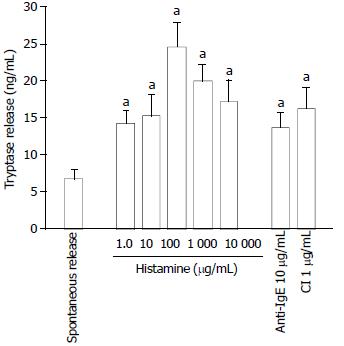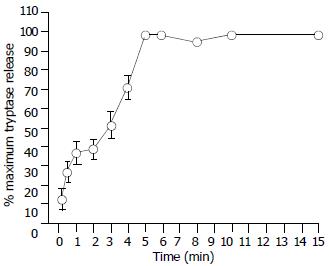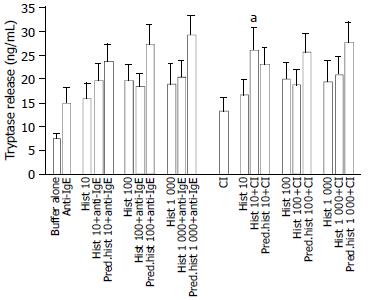Copyright
©The Author(s) 2004.
World J Gastroenterol. Feb 1, 2004; 10(3): 323-326
Published online Feb 1, 2004. doi: 10.3748/wjg.v10.i3.323
Published online Feb 1, 2004. doi: 10.3748/wjg.v10.i3.323
Figure 1 Histamine, anti-IgE and calcium ionophore (CI) in-duced tryptase release from colon mast cells.
The values shown are mean ± SEM for six separate experiments. Stimulus or HBSS alone was incubated with cells for 15 min before termination of the reactions. aP < 0.05 compared with spontaneous release group (paired Student’s t test).
Figure 2 Time course for histamine (100 ng/mL) induced re-lease of tryptase from colon mast cells.
Data shown are mean ± SEM of five separate experiments.
Figure 3 Effect of co-addition of histamine (hist) and anti-IgE or calcium ionophore (CI) on tryptase release from colon mast cells.
The values shown are mean ± SEM for six separate experiments. Various concentrations of histamine and anti-IgE or CI were added to cells at the same time, and then incubated with cells for 15 min before termination of the reactions. aP < 0.05 compared with the corresponding histamine alone group (paired Student’s t test).
Figure 4 Effect of histamine (hist) on anti-IgE or calcium iono-phore (CI) induced tryptase release from colon mast cells.
The values shown are mean ± SEM for six separate experiments. Various concentrations of histamine were incubated with cells for 20 min before addition of anti-IgE or CI. aP < 0.05 compared with the corresponding histamine alone group (paired Student’s t test). Pred.hist + anti-IgE or CI = the sum of tryptase release induced by histamine alone and anti-IgE or CI alone.
- Citation: He SH, Xie H. Modulation of tryptase secretion from human colon mast cells by histamine. World J Gastroenterol 2004; 10(3): 323-326
- URL: https://www.wjgnet.com/1007-9327/full/v10/i3/323.htm
- DOI: https://dx.doi.org/10.3748/wjg.v10.i3.323












